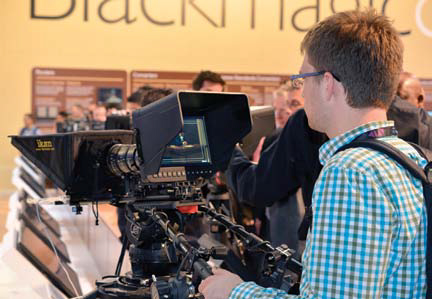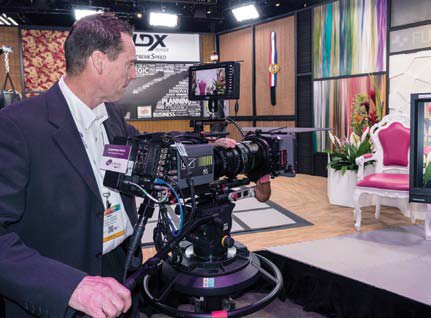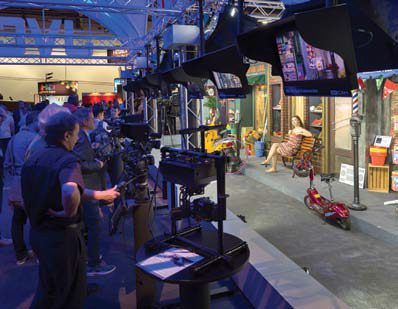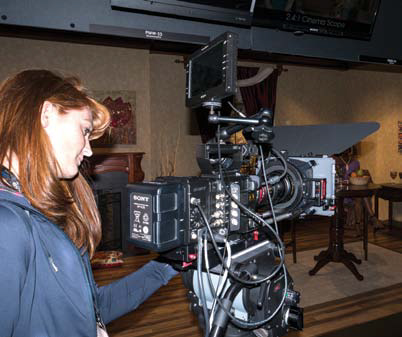NAB Show Product Review: Cameras
A fairly recent NAB Show tradition has been to play “Who’da thunk they’d start building cameras?” Joining the camera club in 2014 was AJA. Meanwhile, there were a spate of other 4K camera introductions and new benchmarks set in high-speed imaging.
AJA introduced its CION camera for shooting 4K/Ultra HD and 2K/HD resolutions. It features an ENG shoulder camera form-factor, and provides a global shutter. The CION can output 4K raw data at up to 120 fps via 4x 3G-SDI outputs, and can record directly to AJA Pak SSD media at up to 60fps. The camera’s menu parameters can be controlled on the side of the camera, or remotely via a Web interface and can be accessed through any Web browser via a LAN connection.
ARRI debuted its AMIRA documentary-style camera, available in a range of upgradeable packages. The AMIRA combines the image quality of CFast 2.0 workflows with a form-factor designed for shoulder and tripod-mounted shooting by a single operator. It comes with a variety of 3D LUT-based looks, as well as the ability to build custom LUTs.
Adam Knight of Red Element Studios checks out the Blackmagic Studio Camera. BLACKMAGIC DESIGN unveiled two new 4K video cameras. The URSA is built to handle the ergonomics of a full crew or single shooter, and features the ability to interchange sensors and lens mounts. It comes with a Super 35 global shutter sensor and internal dual RAW and Apple ProRes recorders. The Blackmagic Studio Camera is available in 1080 HD or Ultra HD models, and includes features specifically designed for live production requirements, such as large viewfinder, talkback, tally and optical fiber capability.

CANON introduced two compact video HD cameras, the XF205 and XF200. Both provide greater versatility with a more powerful Canon HD Video System, numerous recording modes, wireless connectivity and an enhanced operational design. Each camera features a 26.8mm wide-angle Canon HD lens with an optical zoom that has been increased to 20x, along with Canon’s latest HD CMOS PRO imaging sensor and 50 Mbps MPEG-2 recording and 4:2:2 color sampling.
FOR-A presented a new version of its FT-ONE 4K super slow-motion camera, providing fiber I/O connections built directly into the unit when shooting from the field. The FT-ONE CMOS global shutter sensor was developed to provide high resolution and sensitivity. RAW material is recorded at high speed to the internal RAM memory, which holds nearly 10 seconds of 4K content shot at 900 fps. And the camera plays back full 4K (4096 x 2160 pixels).
GOPRO unveiled several permutations to its action cameras, including the HERO3+ Black Edition. Twenty percent smaller and lighter than its predecessor, it provides improved image quality and powerful new features such as SuperView for an extreme wide-angle view. Also new was the HERO3+ Silver Edition, with all of the Black Edition’s advantages, but twice as powerful. It captures video at up to 1080p60, and 10 megapixel photos at up to 10 frames per second.
The professional video industry's #1 source for news, trends and product and tech information. Sign up below.

Paul De Bresser with Grass Valley demonstrates the company’s new LDX XtremeSpeed 4K Ultra camera.GRASS VALLEY introduced four new additions to the LDX camera range: the LDX HiSpeed (LDX HS) and LDX Compact HiSpeed (LDX Compact HS) 3X super slow-motion cameras, and the LDX XtremeSpeed (LDX XS) and LDX Compact XtremeSpeed (LDX Compact XS) 6X ultra slow-motion cameras. The company also showed technology to produce 4K images from a three-chip, 2/3-inch camera. Though the chips use an HD array of pixels, GV uses advanced processing to build 4K images from those sensors.
HITACHI KOKUSAI debuted its Z-HD6000 CMOS HDTV studio camera, which features a 2/3-inch 2.6 megapixel 1920 x 1080 CMOS RGB sensor. It features RLAC (real-time lens aberration correction) and DNR (dynamic noise reduction) circuitry. The company also showed an 8K camera it has developed for Japan’s NHK research laboratories.
I-MOVIX showcased its new line of products based on its X10 ultra-slow-motion technology. Using its internal memory, the X10 high-speed camera can image in full HD at more than 2,000 fps, and 1,000 fps in 4K. The X10’s deflickering technology eliminates light strobing, and the entire X10 product range has been optimized to be upgraded for evolving requirements and new cameras.
IKEGAMI debuted its HDK-97ARRI broadcast camera form-factor ARRI Alexa, produced in partnership with ARRI. The camera delivers digital cinema characteristics, and makes it possible to employ a large-format sensor in multiple camera operation. Also featured by Ikegami was the HDK-95C Unicam HD, utilizing next-generation 2.5 megapixel high-performance CMOS sensors with the ability to produce in a wide array of formats.

Attendees try out the cameras in the JVC booth.JVC introduced its 800 Series cameras, which consists of the GY-HM890U and the GY-HM850U. Both feature three, 1/3- inch 2.07 effective megapixel CMOS sensors that capture full 1920 x 1080 images, and are delivered with new Fujinon wide-angle 20x zoom lenses that feature auto focus, built-in optical image stabilization and chromatic aberration correction. Both camcorders can also have a cellular modem plugged into them for built-in liveshot capability. The company also debuted four new 35mm sensor 4K cameras.
NAC IMAGE TECHNOLOGY showcased its Hi-Motion II ultra-slow-mo camera system, a three 2/3- inch chip camera that mounts standard HD ENG or box-style lenses. It can capture more than 10x high-speed images in full HD (1920 x 1080). The Hi-Motion II provides a 4x improvement in light sensitivity compared to the company’s original Hi-Motion camera system.
NIKON unveiled a new generation of its DSLR, the Nikon D4S. Though primarily designed as a still camera, it has features such as advanced intervalometry that is useful to either still or motion picture camera crews, along with a time-lapse movie mode. It features an HDMI output and a plug-in mic port, and shoots at 1080p60, which can be recorded in H.264 on an internal memory card and simultaneously to an external recorder if so desired.
PANASONIC introduced three new VariCam cameras designed around the AVCULTRA codec. The AJ-PX270 is designed for ENG, sports, reality and production work. The 4K VariCam 35 is a 35mm sensor 4K camera that supports P2 ULTRA workflow as well as a RAW workflow. The VariCam 35 has a modular design, with a 4K camera head attached by umbilical cord to the recorder. The VariCam HS (high speed) is a MOS 2/3-inch camera designed to shoot full HD at up to 240fps.

Jill Brooks with River Design checks out the Sony F55 4K camera.
RED DIGITAL CINEMA unveiled its 4K Broadcast Module. It provides for streaming live, uncompressed footage at 60 fps. The module is compatible with Red’s Epic Dragon and Scarlet Dragon cameras, and has provisions for multicamera productions.
SAMASERVE showcased its Nipros LS-750/GT camera-mounted fiber adapter system, which works with any 4K camera to simultaneously pass 4K and HD signals uncompressed. The LS-750/GT camera-mounted fiber adapter system provides five 3G-SDI downstreams directly out of the camera, as well as one return of 3G/HD-SDI/SD-SDI signals. All types of 4K plus HD, or five separate HD streams, can be transported simultaneously, with the ability to mix the five asynchronous 3G/HD/SD streams independently.
SONY introduced its Alpha 7s DSLR mirrorless full-frame camera, built around a brand new, 12-megapixel, full-frame sensor. The company also that the 4K F5 camera can be upgraded to an F55, and v4.0 firmware is available for both cameras. Sony also introduced a shouldermount docking station for the F5 and F55, which puts controls where shoulder camcorder users are used to finding them. The company also announced Avid DNxHD and Apple ProRes codecs for the F5 and F55.
VISION RESEARCH presented its third-generation digital cinema camera. Designed for cinematographers, the Phantom Flex4K is a high-speed camera providing a wide range of frame rates, from 15 fps up to 1,000 fps at 4K, and up to 2,000 fps at 2K/1080p. The camera’s Cine RAWformat provides fast high-speed capture on set. Files are saved to the hot-swappable Phantom CineMag IV, up to 2 TB.
